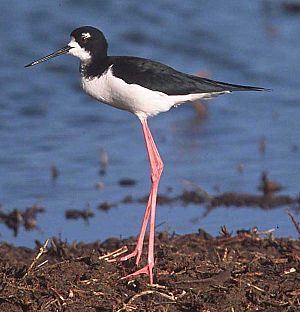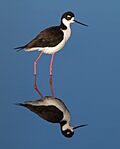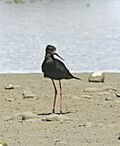Recurvirostridae facts for kids
Quick facts for kids Recurvirostridae |
|
|---|---|
 |
|
| Hawaiian stilt | |
| Scientific classification |
|
| Kingdom: | Animalia |
| Phylum: | Chordata |
| Class: | Aves |
| Order: | Charadriiformes |
| Suborder: | Charadrii |
| Family: | Recurvirostridae Bonaparte, 1854 |
| Genera | |
|
|
The Recurvirostridae are a family of birds that live near water. They are often called waders because they walk in shallow water to find food. This bird family includes two main groups: the avocets and the stilts.
Contents
About Avocets and Stilts
Avocets and stilts are medium-sized birds. They are usually about 30 to 46 cm (12 to 18 in) long and weigh between 140 to 435 g (4.9 to 15.3 oz). Male birds are often a little bigger than females.
All these birds have long, thin legs, long necks, and long bills (beaks). Avocets have bills that curve upwards. They swing their bills from side to side in salty or brackish (slightly salty) water to find food. Stilts, on the other hand, have straight bills.
Their front toes are partly webbed, which helps them walk on soft ground. Avocets and the banded stilt have fully webbed feet, which means they are better at swimming. Most species have black and white feathers, but some also have patches of brown or buff (a pale yellowish-brown) on their heads or chests. Male and female birds look very similar.
These birds usually make short, yelping sounds with one or two syllables.
Where They Live
Avocets and stilts live all over the world, on every continent except Antarctica. You can also find them on many islands in the ocean. Some species live in many different places, while others are found only in small areas.
One special bird, the black stilt from New Zealand, is in great danger. It is critically endangered. This is mainly because they are losing their homes, new animals that hunt them have been brought into their areas, and they sometimes breed with other types of stilts.
What They Eat
These birds eat small animals that live in water. Their diet includes things like mollusks (like snails), brine shrimp and other small crustaceans (like crabs), young insects, segmented worms, tadpoles, and tiny fish.
Life Cycle
Stilts and avocets build their nests on open ground close to water. They often nest together in loose groups called colonies. They are very protective of their nesting areas. They will make loud noises and act aggressively to scare away intruders or animals that might try to eat their eggs or chicks.
These birds are monogamous, meaning they stay with one partner during the breeding season. However, they usually find a new partner each year. Their eggs are light-colored with dark marks and weigh about 22 to 44 g (0.78 to 1.55 oz). They usually lay three to four eggs in simple nests. Both parents take turns sitting on the eggs to keep them warm. This incubation period lasts for 22 to 28 days.
The banded stilt is a bit different. It might only breed every few years. This is because they breed near temporary lakes that form after heavy rains in the deserts of Australia.
When the chicks hatch, they are covered in soft down and can leave the nest within a day. They learn to fly (fledge) in 28 to 35 days. For most species, the parents take care of the chicks for several months. They might even move them to new areas and protect them there. But banded stilts are unique: they gather their chicks into huge groups called crèches, which can have hundreds of young birds!
Types of Avocets and Stilts
Scientists sometimes debate how many different types of stilts there are. Here are some of the species in the Recurvirostridae family:
| Species in the family Recurvirostridae | |||
|---|---|---|---|
| Common and scientific names | Image | Where they live | Notes |
| Banded stilt Cladorhynchus leucocephalus |
 |
Southern Australia | |
| Black-winged stilt Himantopus himantopus |
 |
Europe, Asia, and Africa | Sometimes includes pied, white-backed, and black-necked stilts as types of this species. |
| Pied stilt Himantopus (himantopus) leucocephalus |
 |
Southeast Asia to Australia and New Zealand | |
| White-backed stilt Himantopus (himantopus/mexicanus) melanurus |
 |
South America | |
| Black-necked stilt Himantopus (himantopus) mexicanus |
 |
North America to northern South America, and Hawaii | Includes the Hawaiian stilt and sometimes the white-backed stilt as types of this species. |
| Black stilt Himantopus novaezelandiae |
 |
South Island of New Zealand | |
| American avocet Recurvirostra americana |
 |
North America | |
| Andean avocet Recurvirostra andina |
 |
Andes mountains in South America | |
| Pied avocet Recurvirostra avosetta |
 |
Europe, Asia, and Africa | |
| Red-necked avocet Recurvirostra novaehollandiae |
 |
Australia | |

